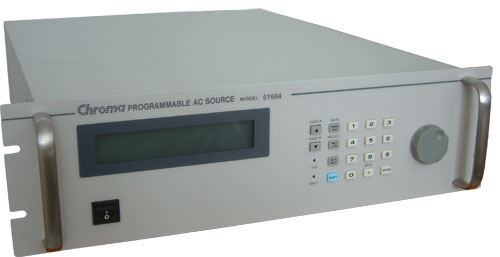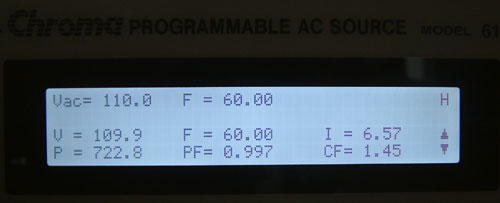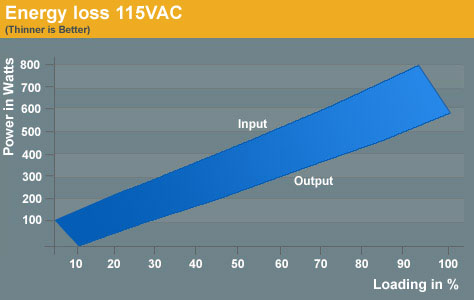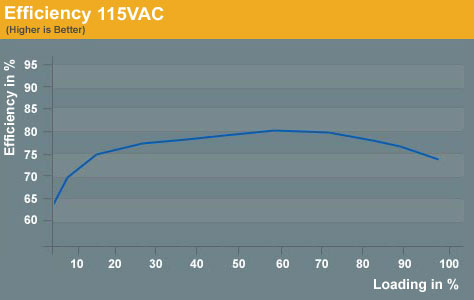AnandTech Power Supply Test Methodology
by Christoph Katzer on July 12, 2007 12:00 AM EST- Posted in
- Cases/Cooling/PSUs
Chroma Programmable AC Source 61604

In most parts of the world it is usual to use a grid power of 230VAC with a frequency of 50Hz. In the US, Canada, and parts of South America however the standards are around 117VAC with a frequency of 60Hz (commonly rounded to 120VAC). To provide our readers the maximum range the units can handle, we are testing power supplies with multiple inputs in these different voltage ranges.
The difference in the DC output between 110VAC and 120VAC is marginal, but from 120VAC to 230VAC it's another story. Lower input voltage results in a higher energy usage by the power supply, and higher power usage lowers the efficiency of each power supply. Therefore we will see differences between tests at 115VAC and those at 230VAC. By covering these two different input voltages of 115VAC and 230VAC we will offer a good variety for all our readers and we will provide the only current public tests conducted at both input voltages.
The Chroma model 61604 is capable of providing 0 - 300VAC with a power up to 2000 volt-amperes (VA). The output frequency can be selected between 15Hz and 1000Hz. To simulate a perfect environment we use 50Hz for the test with 230VAC and 60Hz for 115VAC, which is what users generally find at the power grid in various countries.
However, our AC Source actually provides two functions. The first is that it acts as a normal AC Source, allowing us to test with different voltages. Second, it is also a power meter that gives us important data like power usage and power factor.

The display shows us several important numbers. The top row contains information regarding the power that we want the device to deliver. The two lower rows display the actual delivered voltage, power consumption from the power grid, frequency, power factor, current and the crest factor. For our tests the most important items are the voltage, frequency, power consumption and power factor. In our reviews we will include a graph which will show the energy loss from the power supply during testing as follows.

Sample Energy Loss
The upper line marked with Input is the actual power drawn from the power grid. The line below marked with Output is the DC power which is given to the PC. Usually at lower power draws from the system the power loss will be lower as well. This can be seen by the increasing distance between the two lines, which grows steadily with increasing power usage.
By loading a power supply at a specific level, we get both the power input and the power output. Dividing these two units gives the efficiency of each tested power supply. Efficiency has become a modern benchmark for power supplies and many companies build their complete marketing strategy on high efficiency. To make this efficiency readable we will use a graph which shows each step at a specific point of load. To get the best overall impression of a power supply we decided to test in steps of 10% of the actual load each power supply is able to deliver. The load of each rail is calculated in conformity with the Power Supply Design Guide V1.1 released by Intel in March of this year.

Sample Efficiency
The efficiency is normally displayed in a curve which starts at a low point around 60 to 70%. With increasing loads the curve will usually reach its zenith at 50% to 70% of the maximum load the power supply can handle. This means that at this point the power supply has its best efficiency and ideally it should spend most of its time running in this area. High loads push the power supply beyond this point to where the curve is normally heading down again.
The important thing to take away from this is that it's not easy to buy a perfect power supply for the home PC and a little bit of calculation needs to be done. Remember that the power supply should not run at lower or higher loads most of the time. The former happens when a user buys a power supply that provides more potential power than they need, while the latter occurs when users purchase power supplies that meet their minimum requirements. This is information that many marketing departments aren't interested in disseminating, however, and some companies are advertising power supplies rated at more than 1000W - something which few if any PCs will need at the moment.

In most parts of the world it is usual to use a grid power of 230VAC with a frequency of 50Hz. In the US, Canada, and parts of South America however the standards are around 117VAC with a frequency of 60Hz (commonly rounded to 120VAC). To provide our readers the maximum range the units can handle, we are testing power supplies with multiple inputs in these different voltage ranges.
The difference in the DC output between 110VAC and 120VAC is marginal, but from 120VAC to 230VAC it's another story. Lower input voltage results in a higher energy usage by the power supply, and higher power usage lowers the efficiency of each power supply. Therefore we will see differences between tests at 115VAC and those at 230VAC. By covering these two different input voltages of 115VAC and 230VAC we will offer a good variety for all our readers and we will provide the only current public tests conducted at both input voltages.
The Chroma model 61604 is capable of providing 0 - 300VAC with a power up to 2000 volt-amperes (VA). The output frequency can be selected between 15Hz and 1000Hz. To simulate a perfect environment we use 50Hz for the test with 230VAC and 60Hz for 115VAC, which is what users generally find at the power grid in various countries.
However, our AC Source actually provides two functions. The first is that it acts as a normal AC Source, allowing us to test with different voltages. Second, it is also a power meter that gives us important data like power usage and power factor.

The display shows us several important numbers. The top row contains information regarding the power that we want the device to deliver. The two lower rows display the actual delivered voltage, power consumption from the power grid, frequency, power factor, current and the crest factor. For our tests the most important items are the voltage, frequency, power consumption and power factor. In our reviews we will include a graph which will show the energy loss from the power supply during testing as follows.

Sample Energy Loss
The upper line marked with Input is the actual power drawn from the power grid. The line below marked with Output is the DC power which is given to the PC. Usually at lower power draws from the system the power loss will be lower as well. This can be seen by the increasing distance between the two lines, which grows steadily with increasing power usage.
By loading a power supply at a specific level, we get both the power input and the power output. Dividing these two units gives the efficiency of each tested power supply. Efficiency has become a modern benchmark for power supplies and many companies build their complete marketing strategy on high efficiency. To make this efficiency readable we will use a graph which shows each step at a specific point of load. To get the best overall impression of a power supply we decided to test in steps of 10% of the actual load each power supply is able to deliver. The load of each rail is calculated in conformity with the Power Supply Design Guide V1.1 released by Intel in March of this year.

Sample Efficiency
The efficiency is normally displayed in a curve which starts at a low point around 60 to 70%. With increasing loads the curve will usually reach its zenith at 50% to 70% of the maximum load the power supply can handle. This means that at this point the power supply has its best efficiency and ideally it should spend most of its time running in this area. High loads push the power supply beyond this point to where the curve is normally heading down again.
The important thing to take away from this is that it's not easy to buy a perfect power supply for the home PC and a little bit of calculation needs to be done. Remember that the power supply should not run at lower or higher loads most of the time. The former happens when a user buys a power supply that provides more potential power than they need, while the latter occurs when users purchase power supplies that meet their minimum requirements. This is information that many marketing departments aren't interested in disseminating, however, and some companies are advertising power supplies rated at more than 1000W - something which few if any PCs will need at the moment.










49 Comments
View All Comments
sprockkets - Saturday, July 14, 2007 - link
I've used a kill a watt device to test for pfc, seems most computers are around 0.6 to 0.64. My old Shuttle box with a replaced power supply with active pfc gets a 0.95 pfc.Phlargo - Thursday, July 12, 2007 - link
This is an excellent commitment to a quality review methodology which will not only benefit the Anandtech community, but the whole power supply industry if the message here is taken to heart by consumers. That anandtech has decided to actively create a reliable and consistent power supply review rig is just another example of exactly why I have come to this great site for so many years.Great work!
mostlyprudent - Thursday, July 12, 2007 - link
My thoughts exactly!qpwoei - Thursday, July 12, 2007 - link
How fast can you ramp the current on that rig? I'd be very interested to see how PSUs respond to sudden changes in power usage (caused by sudden changes in CPU/GPU load, HDDs spinning up/down, etc).Even if the fancy equipment can't handle it, measuring this shouldn't be too hard with a cheap digital scope and a 20W passive load. Put the probe on the 12V rail to be measured, attach one end of the load to ground, attach the trigger to the high side of the load, then connect the high side of the load to the 12V rail. Should give a nice edge to trigger on. The trick would be connecting the high side fast enough. A switch/relay would probably be too slow, though a bank of MOSFETS should do the job fine. Actually, the current to turn on the MOSFET bank itself would be a good transient test :)
Also, I think a far more interesting thing with respect to temperature is how the PSU reacts to elevated temperatures, as opposed to temperature WRT load. Since a lot of cheaper PSUs are rated at 20 deg C, I'd expect to see them struggling to supply full power at 40 deg C or so. You'd need to regulate the intake air temperature, but that shouldn't be too hard.
JonnyBlaze - Thursday, July 12, 2007 - link
looks like it can do it.
qpwoei - Friday, July 13, 2007 - link
That's the "mains" supply thing. I noticed that you can read the module number in one of the shots, and it appears that the 63103 can do dynamic load tests - 5 A/us slew with adjustable repetition rates should do the job nicely. I'd be really, really interested to see some results from this.ATWindsor - Thursday, July 12, 2007 - link
Hopefully you will be using the box for some other SPL-measurments on equipment that is not a PSU also?AtW
WW2Planes1 - Thursday, July 12, 2007 - link
Great looking setup. (I love the sound isolating box). I Finally feel like I'll actually learn something from a power supply review.I agree with BladeVenom, I really hope to see some midrange/budget PSUs as well as the higher end ones.
One other thing that would be nice to see in reviews (not just the power supply ones), is longer term reliability. Most things (and especially computer components), aren't really built with longevity in mind, and with certain critical components (power supplies, hard drives, etc) it would be nice to know if certain companies build longer lasting products than others. I understand the difficulties involved with something like that, so I don't really expect to see it, but it would be nice.
TA152H - Thursday, July 12, 2007 - link
I'm not sure midrange or budget power supplies are ever a great idea, unless they are just low power units. A couple of times I bought cases with these power supplies, and was just plopping an old motherboard in it so I didn't care too much, and found they are really problematic. They poison everything downstream from them, which is pretty much everything, and they do nothing good for the reliability of the system, and of course greatly reduce the lifespan of it.The one part of system that should never be compromised on is the power supply. A slower processor or video card might work fine for most people, and if it's not fast enough, it's not catastrophic. A poorly made power supply can have catastrophic consequences and whatever money you save on it, it can cost you later on in multiples of it. You can't make a good power supply out of bad components either, so I don't see how a low cost power supply could impress. Even if it did fairly well in their tests, I'd have serious concerns about the reliability and what will happen to it as time goes along. Low cost power supplies can't be using the same high quality parts, after all.
I'm not knocking power supplies that cost a little because they have relatively low power output. I'm saying if you see an 800 watt power supply that is costing 40% less that other quality 800 watt power supplies with the same feature set, you're asking for trouble buying it. You don't roll dice with power supplies.
Still, it might be interesting just to see the differences quantified, between low and high quality power supplies. I just hope it doesn't lead to people buying the low quality junk. That would be a terrible disservice. It's better to save money on ANY other part of the system before the power supply.
mostlyprudent - Thursday, July 12, 2007 - link
When I think of midrange PSUs, I think of lower wattage models (380-450) by reputable vendors. However, as the article mentions, there are a lot of new players popping up in this market. Hopefully that kind of competition is leading to more competative pricing. It may cease to be true that you need to spend over $100 to get a high quality PSU.My point is that there may be some real value to testing less expensive PSUs.
I get the impression from this article that AT will test a wide range of PSUs (from a wattage standpoint). I hope that is the case. There is nothing more frustrating to me than finding reputable review sites who don't have any recomended PSUs below the 700 watt level.